Physical Address
304 North Cardinal St.
Dorchester Center, MA 02124
Physical Address
304 North Cardinal St.
Dorchester Center, MA 02124
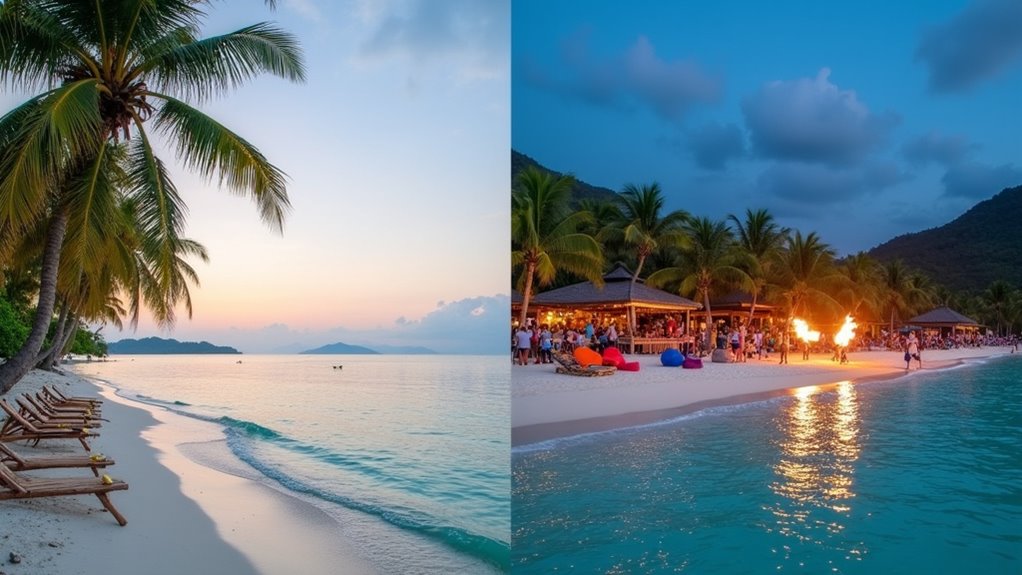
Islands clash in Indonesia's paradise: Gili Air's serenity or Gili Trawangan's parties—your perfect escape hinges on this crucial decision.
Making the wrong island choice could turn your Indonesian vacation into a memorable experience—for all the wrong reasons. You’re likely facing the classic Gili dilemma: Trawangan’s vibrant party atmosphere or Air’s peaceful retreat? Each island offers crystal-clear waters and stunning beaches, but they cater to dramatically different travel styles. Your ideal paradise depends entirely on what you want from your getaway. Are you seeking late-night revelry or tranquil sunsets? The answer will determine which Gili island deserves your precious vacation days.
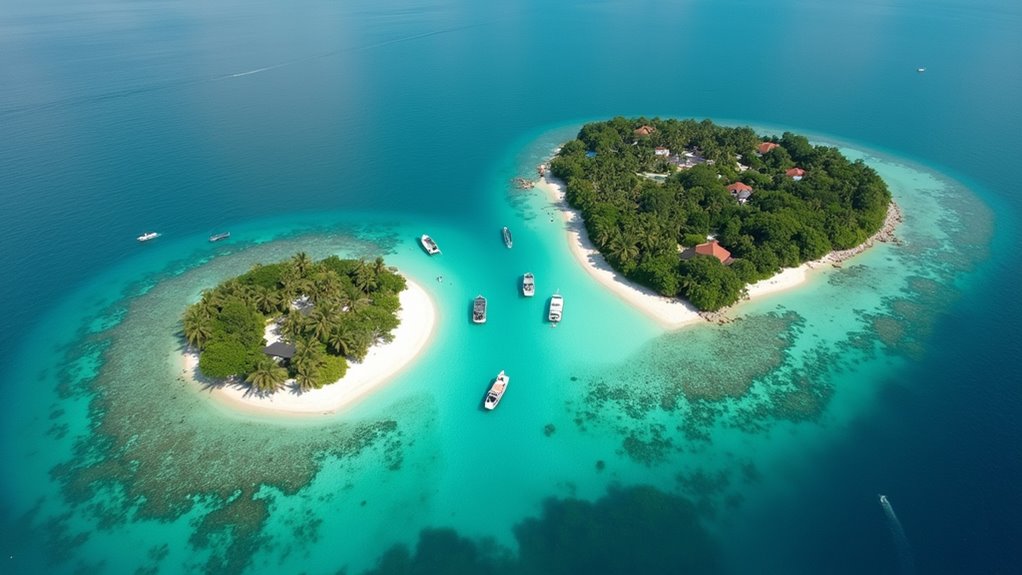
When choosing between Gili Air and Gili Trawangan, size is an important factor to contemplate. Gili Trawangan is the largest of the Gili Islands, covering about 6 km² – roughly twice the size of Central Park in New York. You can walk around its 6.5 km coastline in about two hours.
Gili Air, while smaller than Trawangan, offers a more compact experience that’s still larger than tiny Gili Meno. Both islands feature flat topography, making them easily explorable by foot or bicycle. For travelers seeking a perfect quick getaway, these islands provide a similar experience to Nusa Penida’s beaches but with their own distinct character.
Geographically, both islands sit in the Lombok Strait near Mount Rinjani, with Bali visible on clear days. They share similar tropical climates with distinct wet and dry seasons, and are surrounded by coral reefs perfect for snorkeling and diving. Gili Trawangan rises about 30m above sea level, offering elevated viewpoints for stunning panoramas of the surrounding waters.
Beyond the physical dimensions of these islands, their development levels and infrastructure markedly shape your experience. Gili Trawangan is more developed, boasting a wider range of accommodations from budget hostels to luxury resorts, while Gili Air offers a more modest selection.
Infrastructure shapes paradise—Trawangan offers diverse luxury to budget stays while Air maintains simplicity with fewer options.
Both islands face similar challenges – power outages occur regularly, waste management struggles to keep pace with tourism growth, and water resources are under pressure. Internet connectivity has improved but remains inconsistent.
Transportation is basic on both islands with no motorized vehicles – you’ll rely on bicycles, horse carts, or walking. Trawangan’s infrastructure supports its bustling nightlife and shopping, whereas Air maintains a quieter atmosphere with fewer facilities. Visitors looking for immersive sunset experiences will find both islands offer stunning views with comfortable bean bags placed along the northern beaches.
For foodies, both islands provide opportunities to sample authentic Balinese cuisine with its rich flavors and fresh ingredients that define the local food culture.
Your preference depends on whether you value convenience and options or seek a more laid-back, less developed island experience.
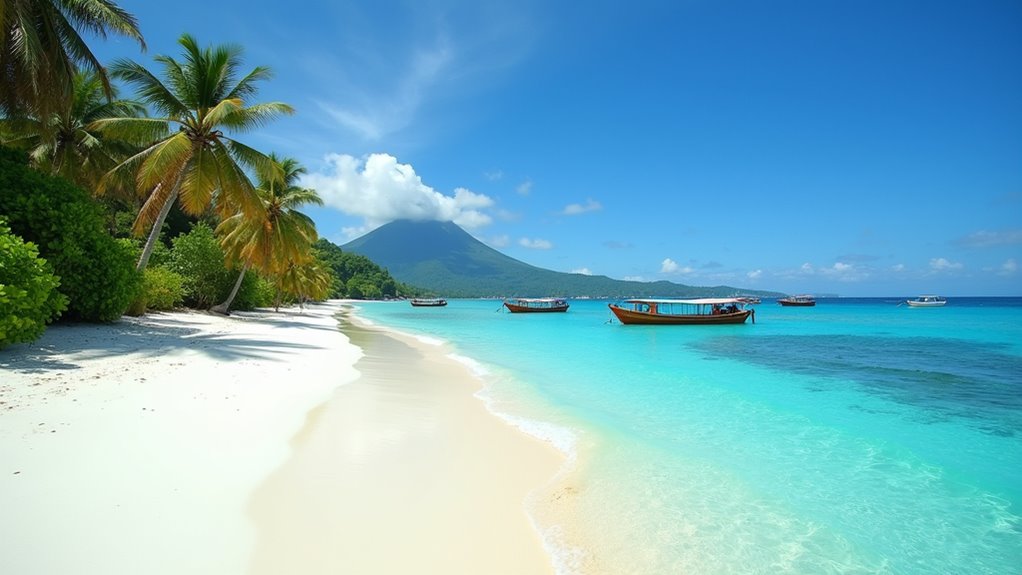
The beaches and swimming conditions on both Gili islands directly impact your holiday experience, though in distinctly different ways.
Gili Trawangan offers more variety with beaches like North East, Sunset, Malibu, and Good Heart – all easily accessible by foot or bike. Sunset Beach stretches over 2km and is perfect for horse riding and watching the sun dip below the horizon.
Both islands boast clear turquoise waters ideal for swimming, but Gili Air provides more secluded spots with fewer crowds.
While swimming is generally safe in the shallow waters surrounding both islands, be mindful of occasional strong currents.
If you’re seeking vibrant beach life with numerous amenities, head to Trawangan. For tranquil swims in less crowded waters, Gili Air might be your better match.
Cycling enthusiasts will appreciate that the sandy and rocky roads on both islands provide a unique beachside riding experience despite occasional challenging terrain.
After a day of swimming, you might enjoy a Balinese massage to soothe tired muscles while listening to the gentle waves lapping at the shore.
Both Gili islands offer a wealth of activities to fill your days, complementing their beautiful beaches. You’ll find snorkeling, diving, and island hopping available on both Gili Air and Gili Trawangan, with excellent turtle spotting opportunities during your underwater adventures.
Gili Trawangan provides more water sports options including kayaking, paddle boarding, and kite surfing—perfect if you’re seeking variety.
Both islands feature dive schools offering certification courses in warm, clear waters where shark sightings are possible. If you’re planning a longer journey through Indonesia, consider that these islands are an excellent starting point before taking the land travel route to Jakarta.
For land exploration, rent a bicycle or take a horse carriage tour around either island—no cars or motorbikes are allowed. Gili Air’s network of sandy paths crisscrosses the entire island, creating a nostalgic, timeless feeling as you explore.
Coastal walks reward you with stunning sunrise and sunset views. While both islands maintain a peaceful atmosphere, Gili Air tends to be quieter compared to the more activity-rich Trawangan.
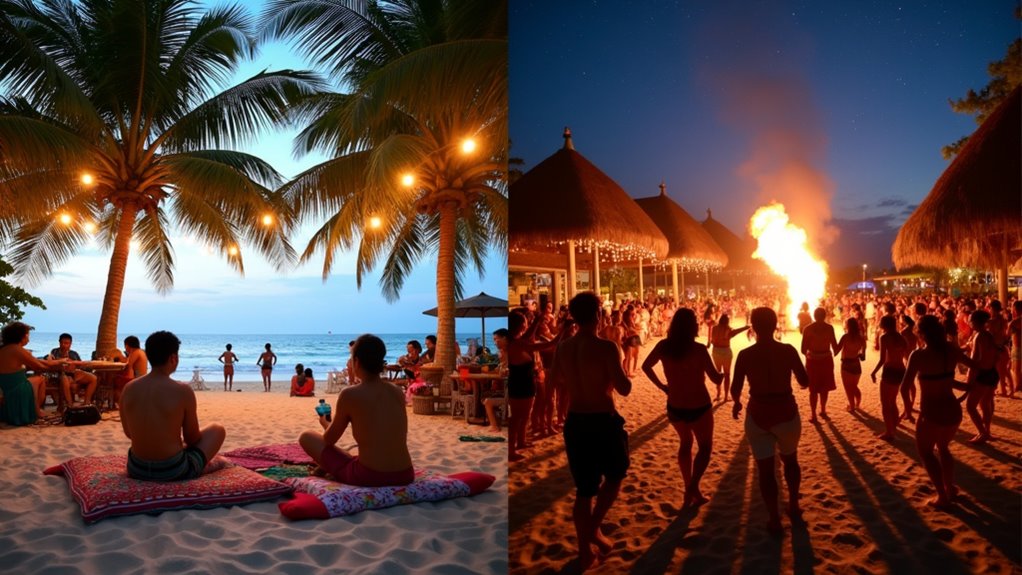
Choosing between Gili Air and Gili Trawangan often comes down to your preferred nightlife experience.
Gili Trawangan delivers vibrant, energetic nightlife with loud club music and a party atmosphere centered around the island’s jetty area. The island hosts exciting full moon parties featuring fire dancers, neon lights, and talented DJ performances. Expect a fast-paced social scene that attracts party-goers looking for excitement into the late hours.
In contrast, Gili Air offers a laid-back alternative with reggae music and live performances creating a chill beach vibe. Venues like Legend Bar, Pelangi, and Zipp Bar host regular live music events with beachfront settings. Those wanting a more upscale experience might appreciate that the ambiance resembles some of Bali’s beach clubs in Uluwatu, but on a smaller scale.
The relaxed atmosphere provides a perfect balance between socializing and tranquility.
Your choice is simple: opt for Gili Trawangan if you’re seeking energetic clubs and bustling nightlife, or Gili Air for acoustic tunes and relaxed beach gatherings.
When considering accommodations on the Gili Islands, you’ll find distinct differences in style, availability, and price points between the two popular destinations.
Gili Trawangan offers greater variety, from budget hostels under $30 to luxury resorts exceeding $200 nightly. You’ll find more social hostel options if you’re traveling solo, with numerous beachfront properties throughout the island. The Aston Sunset Beach Resort exemplifies mid-range options at $47 per night, situated on the quieter side away from the party areas.
From backpacker hostels to lavish beachfront resorts, Gili T accommodates every budget and travel style.
Gili Air specializes in intimate boutique stays and eco-friendly villas like Villa Tokay. The island caters particularly well to couples and families seeking quieter surroundings. Both islands are recognized as romantic getaways for honeymooners looking to experience Bali’s paradise atmosphere.
While pricing mirrors Gili T’s mid-range ($50-150/night), the focus is on smaller, charming properties rather than large resorts.
Both islands see price increases during July-August peak season, with Gili T offering better infrastructure reliability but Gili Air providing more secluded beachfront experiences.
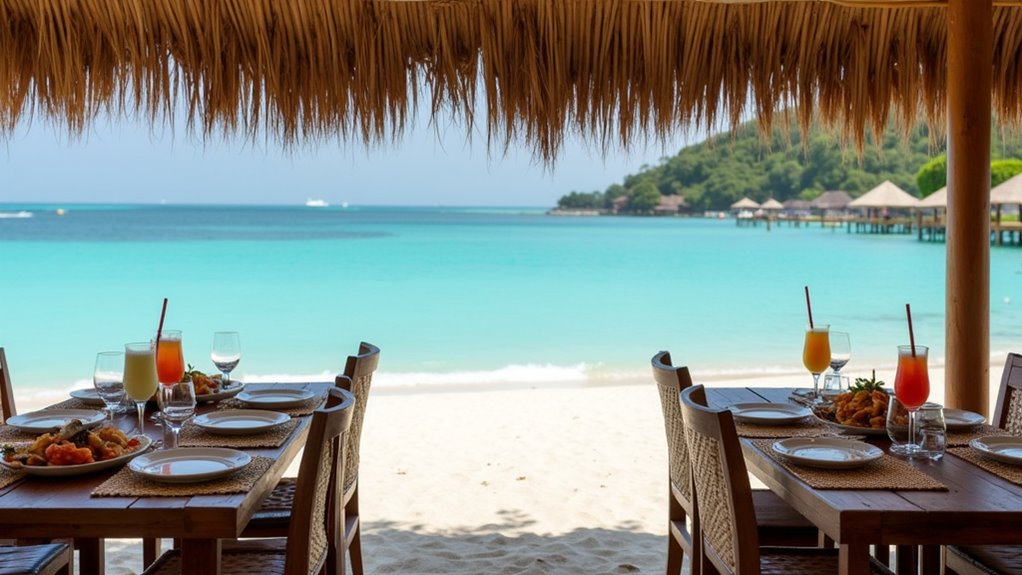
Food experiences markedly differ between Gili Trawangan and Gili Air, despite their proximity. Gili Trawangan offers diverse international cuisines including Thai and Mexican, plus numerous vegetarian and gluten-free options at spots like Jali Kitchen and Coco Cafe.
Gili Air emphasizes fresh, local ingredients and hosts fine dining establishments like Dolcemare Italian restaurant. Both islands serve abundant seafood and maintain casual beachfront dining atmospheres.
For budget travelers, local warungs on both islands provide affordable meals, with Gili Air’s Oranges restaurant offering dishes under $3. Meanwhile, Gili Trawangan’s nightlife creates a livelier dining scene with restaurants open late.
When craving something sweet, you’ll find Gili Trawangan’s specialty desserts at Gili Yo Frozen Yogurt or Coco Cafe’s famous pastries and gluten-free brownies. The bohemian décor at many Gili Trawangan restaurants features timber furnishings and comfortable cushions, creating an inviting atmosphere for diners. After dining, visitors can burn off calories with adventure activities like snorkeling or diving at nearby coral reefs.
Just as dining options differ between the Gili islands, so too do the ideal seasons for visiting. Both islands share similar weather patterns, with a dry season from April to October and rainy season from November to March.
For Gili Air, visit between April and October for beach relaxation and calm seas. Water sports enthusiasts should aim for June to August when steady winds create perfect conditions. December offers a unique atmosphere with festive celebrations, though visitors should prepare for frequent rain showers.
Gili Trawangan shines from July to September with vibrant nightlife and ideal weather. If you’re a diver, consider April to June when visibility is excellent with fewer crowds. Many travelers combine their Gili experience with a trip to Lombok island, which offers stunning landscapes and cultural attractions.
Both islands are more expensive and crowded during July and August. For budget travelers, the rainy season (November-March) offers lower prices, though some activities may be limited.
Choose Gili Trawangan if you’re seeking excitement, nightlife, and social energy. Choose Gili Air if you’re craving tranquility, romance, and peaceful days by the sea. You’ll find clear waters on both islands, comfortable accommodations on both shores, and memorable experiences in both locations. Listen to your travel instincts, pick the island that matches your mood, and you’ll make the right decision.